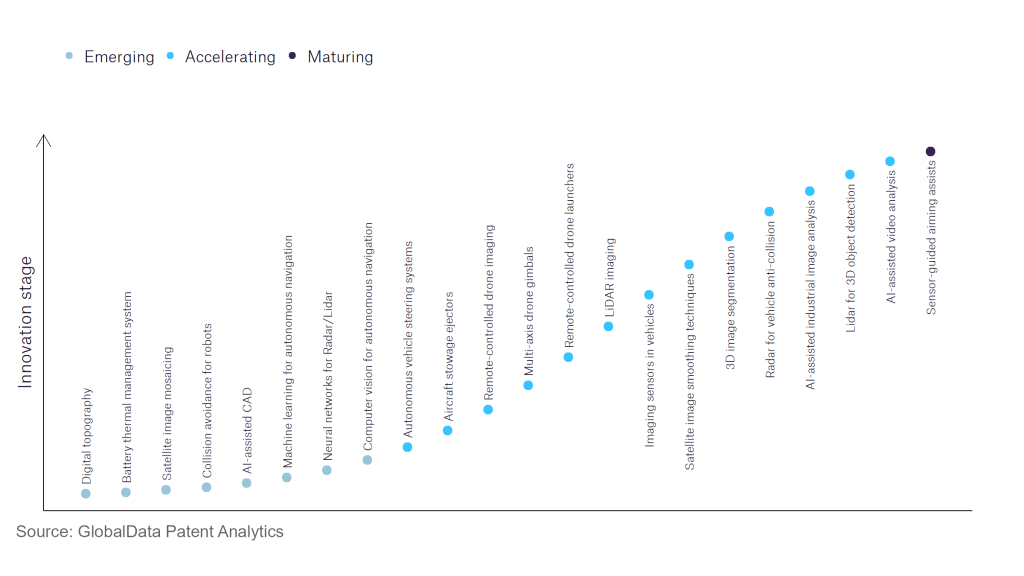The aerospace and defence industry continues to be a hotbed of innovation, with activity driven by developments in artificial technology and machine learning, and the growing importance of technologies such as drones, satellite technology and big data. In the last three years alone, there have been over 174,000 patents filed and granted in the aerospace and defence industry, according to GlobalData’s report on Artificial Intelligence in Aerospace, Defence & Security: 3D image segmentation. Buy the report here.
However, not all innovations are equal and nor do they follow a constant upward trend. Instead, their evolution takes the form of an S-shaped curve that reflects their typical lifecycle from early emergence to accelerating adoption, before finally stabilising and reaching maturity.
Identifying where a particular innovation is on this journey, especially those that are in the emerging and accelerating stages, is essential for understanding their current level of adoption and the likely future trajectory and impact they will have.
180+ innovations will shape the aerospace and defence industry
According to GlobalData’s Technology Foresights, which plots the S-curve for the aerospace and defence industry using innovation intensity models built on over 262,000 patents, there are 180+ innovation areas that will shape the future of the industry.
Within the emerging innovation stage, machine learning for autonomous navigation, battery thermal management system, and satellite image mosaicing are disruptive technologies that are in the early stages of application and should be tracked closely. 3D image segmentation, AV on-board control systems, and lidar for 3D object detection are some of the accelerating innovation areas, where adoption has been steadily increasing. Among maturing innovation areas is sensor-guided aiming assists, which is now well established in the industry.
Innovation S-curve for artificial intelligence in the aerospace and defence industry

3D image segmentation is a key innovation area in artificial intelligence
3D image segmentation means that 3D imaging including computed tomography (CT), micro-computer tomography or MRI scanning can be labelled to isolate regions of interest.
GlobalData’s analysis also uncovers the companies at the forefront of each innovation area and assesses the potential reach and impact of their patenting activity across different applications and geographies. According to GlobalData, there are 120+ companies, spanning technology vendors, established aerospace and defence companies, and up-and-coming start-ups engaged in the development and application of 3D image segmentation.
Key players in 3D image segmentation – a disruptive innovation in the aerospace and defence industry
‘Application diversity’ measures the number of different applications identified for each relevant patent and broadly splits companies into either ‘niche’ or ‘diversified’ innovators.
‘Geographic reach’ refers to the number of different countries each relevant patent is registered in and reflects the breadth of geographic application intended, ranging from ‘global’ to ‘local’.
Patent volumes related to 3D image segmentation
Source: GlobalData Patent Analytics
Alphabet is the leading company in 3D image segmentation, while the company has largely developed its skill in the technology only to the theoretical stage and is likely to develop the technology further. Pictometry International is the second largest patent filer and has developed an image modelling system that utilises 3D image segmentation. Some other key patent filers include Boeing, Raytheon Technologies, and SZ DJI Technology.
In terms of application diversity, LG is the leader, followed by Alphabet and Meta. By geographic reach, Microvision is the leading company, followed by TomTom and Meta.
While the existing applications skew towards healthcare and technology, defence applications include mission planning, training and situational awareness and patents are expected to increase in these sectors in the years to come.
To further understand how artificial intelligence is disrupting the aerospace and defence industry, access GlobalData’s latest thematic research report on Thematic Research: AI in Defense.
Data Insights
From

The gold standard of business intelligence.
Blending expert knowledge with cutting-edge technology, GlobalData’s unrivalled proprietary data will enable you to decode what’s happening in your market. You can make better informed decisions and gain a future-proof advantage over your competitors.



